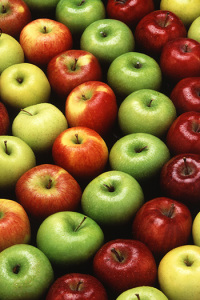An apple a day could keep obesity away

Golden Delicious, Gala, Granny Smith and Red Delicious apples. Photo courtesy of USDA ARS)
“We know that, in general, apples are a good source of these nondigestible compounds but there are differences in varieties,” said food scientist Giuliana Noratto, the study’s lead researcher. “Results from this study will help consumers to discriminate between apple varieties that can aid in the fight against obesity.”
The tart green Granny Smith apples benefit the growth of friendly bacteria in the colon due to their high content of non-digestible compounds, including dietary fiber and polyphenols, and low content of available carbohydrates.
Despite being subjected to chewing, stomach acid and digestive enzymes, these compounds remain intact when they reach the colon. Once there, they are fermented by bacteria in the colon, which benefits the growth of friendly bacteria in the gut.
The study showed that Granny Smith apples surpass Braeburn, Fuji, Gala, Golden Delicious, McIntosh and Red Delicious in the amount of nondigestible compounds they contain.
“The nondigestible compounds in the Granny Smith apples actually changed the proportions of fecal bacteria from obese mice to be similar to that of lean mice,” Noratto said.
The discovery could help prevent some of the disorders associated with obesity such as low-grade, chronic inflammation that can lead to diabetes. The balance of bacterial communities in the colon of obese people is disturbed. This results in microbial byproducts that lead to inflammation and influence metabolic disorders associated with obesity, Noratto said.
“What determines the balance of bacteria in our colon is the food we consume,” she said.
Re-establishing a healthy balance of bacteria in the colon stabilizes metabolic processes that influence inflammation and the sensation of feeling satisfied, or satiety, she said.
The study was funded with an Emerging Research Issues Internal Competitive Grant from the Agricultural Research Center at Washington State University’s College of Agricultural, Human and Natural Resource Sciences.
Contacts:
Giuliana Noratto, WSU Department of Food Sciences, 509-3355-0382, giuliana.noratto@wsu.edu
Sylvia Kantor, WSU CAHNRS Communications, 206-770-6063, kantors@wsu.edu
Media Contact
All latest news from the category: Life Sciences and Chemistry
Articles and reports from the Life Sciences and chemistry area deal with applied and basic research into modern biology, chemistry and human medicine.
Valuable information can be found on a range of life sciences fields including bacteriology, biochemistry, bionics, bioinformatics, biophysics, biotechnology, genetics, geobotany, human biology, marine biology, microbiology, molecular biology, cellular biology, zoology, bioinorganic chemistry, microchemistry and environmental chemistry.
Newest articles

Bringing bio-inspired robots to life
Nebraska researcher Eric Markvicka gets NSF CAREER Award to pursue manufacture of novel materials for soft robotics and stretchable electronics. Engineers are increasingly eager to develop robots that mimic the…

Bella moths use poison to attract mates
Scientists are closer to finding out how. Pyrrolizidine alkaloids are as bitter and toxic as they are hard to pronounce. They’re produced by several different types of plants and are…

AI tool creates ‘synthetic’ images of cells
…for enhanced microscopy analysis. Observing individual cells through microscopes can reveal a range of important cell biological phenomena that frequently play a role in human diseases, but the process of…





















